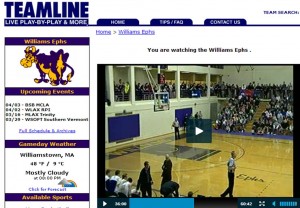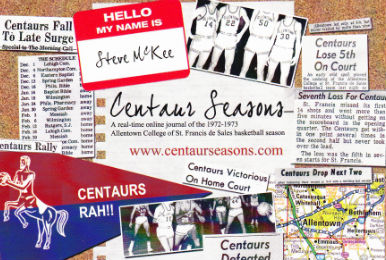Ben Kaplan played basketball at Amherst when the Lord Jeffs reached the 2008 national championship game in Salem. The next season he gave us an inside look at the Lord Jeffs’ 2009 NCAA tournament run. Four years later, Ben went to Atlanta to watch his alma mater play for the national championship. He describes how the Atlanta experience compared to Salem and gives his take on whether the Division III men’s title game should be regularly played at the Division I Final Four site.
Of all the possible confrontations at Saturday’s Final Four in Atlanta’s Georgia Dome, I couldn’t have anticipated the first and only one I would witness. A fifty-ish man in maize, who made the trip with his twenty-ish son from New York, stuck a stubby finger in the face of a sixty-year-old man in purple who sat with his purple-clad daughter one row behind him. A vein pulsed in the man in maize’s forehead and spit flew with each obscenity. Some surrounding fans stepped in and the man in purple quietly stood and summoned security. Hey, you know what they say about Michigan and Amherst fans, right?
For the first time in its history, the NCAA celebrated 75 years of March Madness by crowning the Division II and III champions on the same weekend and in the same city as the D1 Final Four. If public sentiment has any say, it’s a change that the NCAA will make permanent. The D1 and D3 worlds pretend to exist on parallel planes when in fact they collide more often than you might expect. Bringing them together in one event is a fitting and well-deserved honor for the little guys.
The three most recent tournament coaching darlings, Butler’s Brad Stevens, VCU’s Shaka Smart, and Andy Enfield, formerly of Florida Gulf Coast, all played their college ball at Division III schools. Enfield made 92% of his free throws at Johns Hopkins to become the all-time Division III free-throw percentage leader, Smart set Kenyon’s career, season, and single-game assist records, and Stevens contributed for four years at DePauw.
The trio fit the popular D3 mold – scrappers who overcome size and athleticism deficiencies with intelligence, hard work, and often one special skill. D1 fans who dropped by the title game between Amherst College and University of Mary Hardin-Baylor probably expected the crisp passing and sharp shooting Amherst rode to the title, but they probably didn’t expect Amherst wing and Final Four Most Outstanding Player Allen Williamson to grab an offensive rebound on the block, take one dribble to gather himself, and rise up over a defender’s outstretched hand for a thunderous dunk. They probably didn’t expect Mary Hardin-Baylor star Thomas Orr, a lanky lefty who used a variety of crossovers and stepback moves en route to a team-high 24 points, to take off for a slam after a top of the key isolation move in the half court. And they definitely didn’t expect lumbering Amherst center Pete Kaasila to meet him at the rim and send the dunk attempt back. (OK so they called it a foul, but I not-so-objectively thought it was clean. Regardless, it was the second most impressive mid-air meeting in Atlanta called for a foul this weekend.)
Division III normally crowns its champion in Salem, Virginia, a town that hosts the D3 basketball and football championships. This year, the Elite Eight and Final Four were played in Salem two weeks prior to last Sunday’s title game. As a player at Amherst, I attended the 2008 Final Four. It was the school’s third trip to Salem in a row, and the previous year the team won their first national championship.
To get to Salem, we flew a chartered plane instead of our usual bus. A camera crew greeted us when we landed, instructing us to “act naturally” while they filmed. As we waited almost an hour for our coaches to pick up the rental cars, they interviewed a few players about the upcoming weekend. Instead of the usual motel or Howard Johnson, we stayed in a hotel with leather furniture and a fancy restaurant in the lobby. We dealt with never-ending TV timeouts for the first time all year, attended a banquet, and the starters spoke at official press conferences after the game. Little girls play “house,” and that weekend we played “D1 basketball.”
In Atlanta, this year’s Amherst team had a bus waiting for them at an airport and a police escort on each and every trip they made. When I ran into Amherst’s iconic coach, David Hixon, in the hotel lobby, he immediately told me about how thrilled the players were with the lengthy autograph sessions, media interviews, and TV footage shoots. The schedule was wonky, with a pair of two-week layoffs during the tournament, and the weekend was a minefield of distractions, but the players and coaches wouldn’t have had it any other way. For one weekend, they truly got their time on the big stage.
The weekend’s charms weren’t limited to the players. The Final Four hosts the National Association of Basketball Coaches clinics and conferences, which nearly every NCAA coach attends, so I had the pleasure of seeing and speaking to the Amherst graduate assistants from the past seven years who have now moved on to other schools. I sampled the Atlanta nightlife with alums who, myself included, probably wouldn’t have come had the game been in Salem. The D1 Final Four and accompanying activities, like the pop-a-shot games at Bracket Town or the free Ludacris concert at The Big Dance, provide more of an incentive for students and alums to make the trip to support their team. The academic toll of two long trips and a longer season may cause some educators to complain, but the two Amherst players I saw studying for an economics midterm next to the table of NCAA Merchandise in the hotel lobby seemed to manage the juggling act just fine. Half an hour of studying is a small price to pay for a weekend as a VIP at the Final Four.
The game itself took place at Phillips Arena instead of the Georgia Dome for the same reason that ping pong tournaments aren’t held on Centre Court at Wimbledon. National press stopped by to cover the game, and some wrote glowingly about the talent on the floor. They learned a well-kept secret, that the things like late growth spurts, injuries, and a desire for playing time that force bracket busters to attend mid-majors also contribute to low-D1 talents playing on the D3 level. One such talent, Amherst All-American Willy Workman, who had a hip injury in high school that kept him off the D1 radar, spoke at a reception honoring the players after their championship win. He said, “Playing at the D3 level, we don’t get a ton of support, so you guys are our everything. Thanks for being our parents, friends, fans, cooks, laundry-doers, and everything else we needed to get to this point.” Williamson, the Final Four MOP, talked to me about his desire to continue his playing career overseas, as more than a dozen alums in the past have done. “It’s getting a lot more competitive,” he told me, “so hopefully I’ll land somewhere.” To the media, a few Amherst players talked about how they always dreamed of playing in the NBA, and since that was out the window, winning a championship in an NBA arena was next-best thing.
Around 6,000 fans filed into the lower bowl of the Atlanta Hawks home while the upper bowl was curtained off, so the teams got the thrill of playing in a large arena without having it feel empty. At the Dome the previous night, screaming seas of maize, yellow, orange, and red dominated the stands, but at the D3 game the following afternoon, a few rowdy Amherst fans and a screaming Mary Hardin-Baylor student in a purple tutu holding an “Amherst Likes Nickelback” sign were the exception rather than the rule. Physicality and speed didn’t dominate the game as it did on the Division I level, but finesse, athleticism, and tremendous skill were still on display. On my road trip from Chicago to Atlanta, I marveled at the beauty of rolling green hills and the black structures and yellow lights of skylines. Both different, both majestic in their own way. I felt the same about the atmosphere and the on-court performances on Saturday night and Sunday afternoon.
Which brings me back to the confrontation during the Michigan and Syracuse game. The Amherst fan expected his 200-level seats to the Division I Final Four to provide respite from the rowdy student sections. After all, he’s from Amherst, where basketball games are best enjoyed with quiet amusement and occasional polite clapping, preferably with a book on hand. The Michigan fans, who called the players by first name and referred to the team as “we”, wanted to celebrate each basket with a jump, a fist pump, and a high-five. Speaking from personal experience, post-graduation D3 fanhood is more a source of quiet pride than loud and boastful cheers. When “we” used to play on the team and actually know each player by first name, the wild rowdiness seems to us, for whatever reason, a bit over the top. Not that I look down on it. Quite the contrary. I envy it. I wish Amherst results put me in a wild frenzy. I wish I could go to a bar in Chicago on Saturdays and cheer with friends as Amherst beats Middlebury in football. I love when my school wins, and I hate when they lose, but the lack of fanfare and smaller stage puts the game in a different perspective for us.
In the end, both men overreacted. The Amherst alum shouldn’t have grabbed the younger Michigan fan and nudged him down to his seat when he stood up to celebrate a Mitch McGary layup. The older Michigan fan shouldn’t have responded by pushing and swearing at the Amherst alum.
At the heart of that clash were two parents who didn’t want a once-in-a-lifetime experience with their kids at all compromised. The father and son decked out in maize, the father and daughter in Amherst sweaters, my father and me a few seats over, the two Michigan grad students who bought our tickets to Monday’s finals – we were all living out a weekend we would remember and laugh and talk about forever. Watching Amherst win was great, but sharing that experience with my old teammates, seeing the big hugs and bigger smiles on the court, and the tears of the new generation of team parents made it truly special.
That’s why this past weekend should be the beginning of a new tradition. Other Division II and III schools deserve this chance, and other alums should get to experience what I did. Between the overload of endorsements and allegations of athlete exploitation, the NCAA creates these unforgettable shared experiences between athletes and fans alike. Why not maximize them?

 By Steve McKee
By Steve McKee